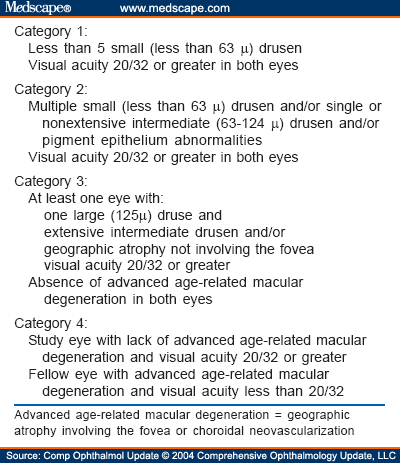Abstract and Introduction
Choroidal neovascularization is the primary cause of visual loss in patients with age-related macular degeneration. Current treatments, proven to offer a benefit for these patients through randomized controlled clinical trials, include laser photocoagulation, photodynamic therapy, and high-dose vitamins and zinc. Laser photocoagulation and photodynamic therapy are used to treat established choroidal neovascularization. High doses of vitamins and zinc are used to prevent the development of this complication. New therapeutic modalities, including antivascular endothelium growth factor strategies, intraocular and periocular injection of steroids, transpupillary thermotherapy, macular translocation, submacular surgery, iris and retinal pigment epithelium transplantation, feeder-vessel photocoagulation, and prophylactic laser photocoagulation, are under investigation.
Age-related macular degeneration (ARMD) is the most common cause of central vision loss in individuals over 65 years of age in developed countries. Patients with ARMD may lose sight as a consequence of geographic atrophy or neovascular ARMD.
Following the International Classification for ARMD,[1] neovascular ARMD (also called exudative ARMD) is characterized by the presence of any of the following: retinal pigment epithelium (RPE) detachment; choroidal neovascularization (CNV); epiretinal (excluding idiopathic macular pucker), intraretinal, subretinal or sub-RPE scar/glial tissue; and subretinal hemorrhage not related to other vascular disease. In a large epidemiological study combining data from United States, the Netherlands, and Australia, the prevalence of pure neovascular ARMD was found to be 0.88%, 0.72%, and 1.20%, respectively.[2] In this study, pure neovascular ARMD was almost twice as prevalent as pure geographic atrophy.
The purpose of this update is to provide an overview of current treatment modalities proven to be of benefit or still under investigation for patients with neovascular ARMD. A very brief summary of current knowledge on the pathogenesis of this disease, which may help the reader to understand the rationale of available treatments, is also given. Tables have been provided to summarize currently available data. However, it should be noted that the studies summarized in these tables are not, in many instances, comparable, since inclusion/exclusion criteria, definition of visual improvement/stabilization/worsening, follow-up, and other parameters may have varied among these different studies.
Compr Ophthalmol Update. 2004;5(3) © 2004 Comprehensive Ophthalmology Update, LLC
Cite this: Neovascular Age-Related Macular Degeneration - Medscape - May 01, 2004.










